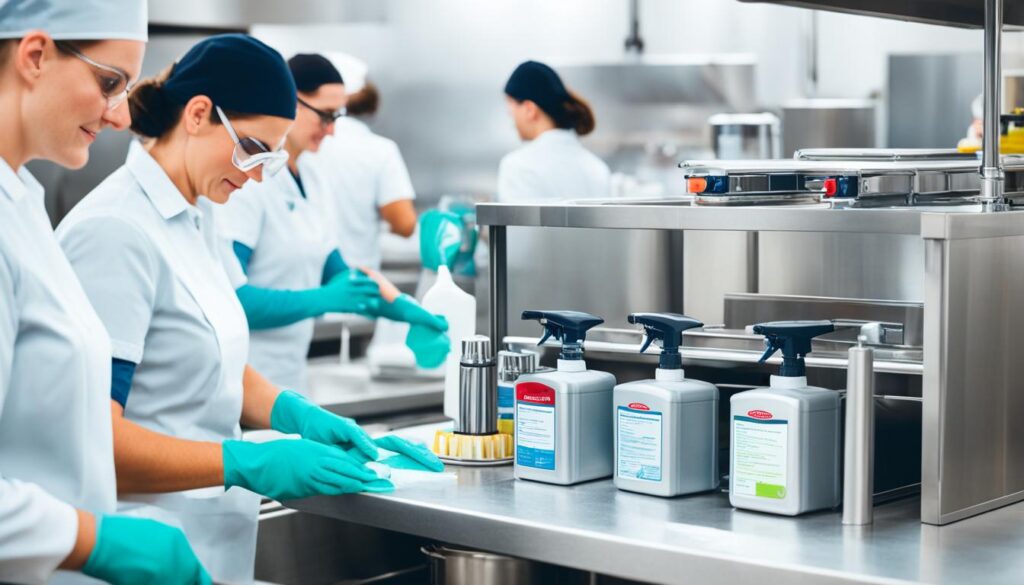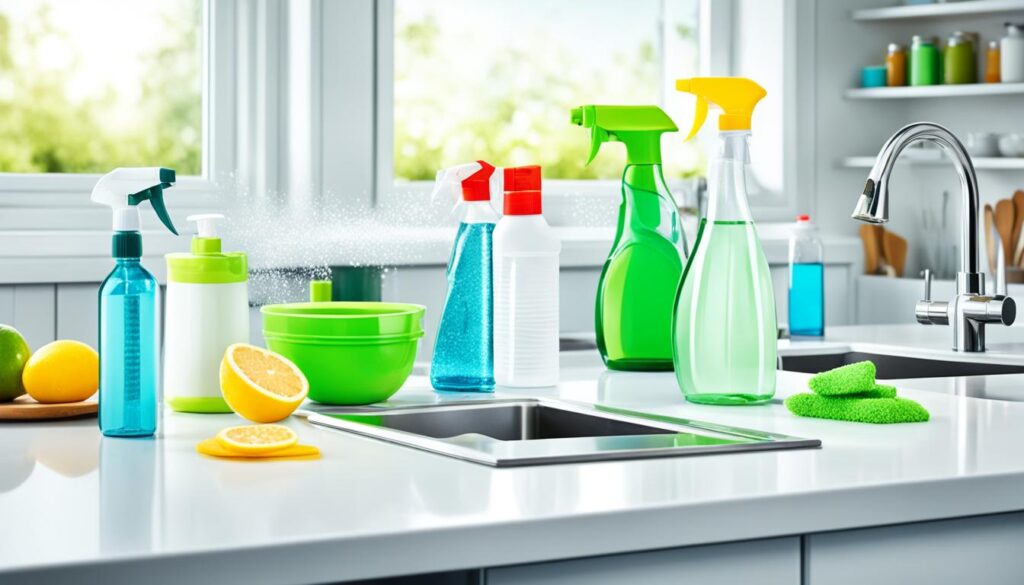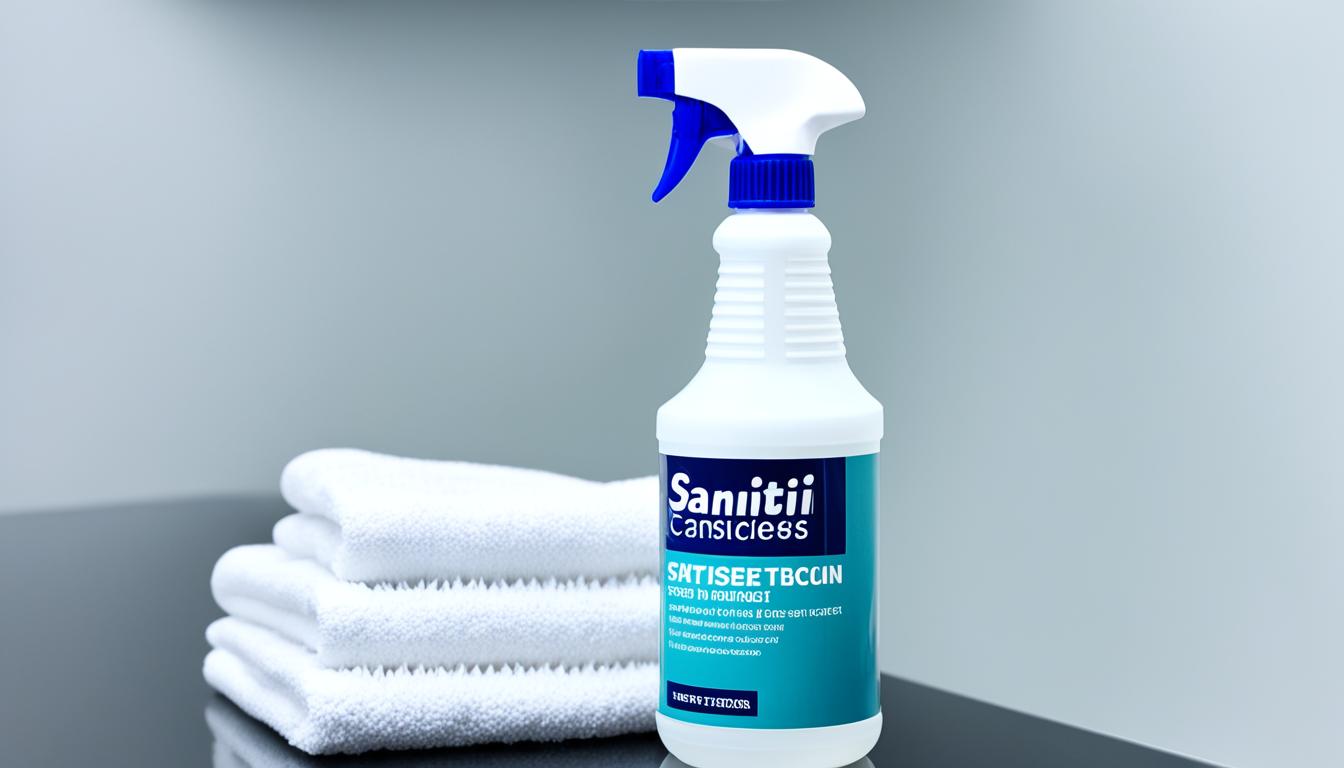When it comes to maintaining a safe and hygienic kitchen environment, food grade sanitisers are essential. These kitchen hygiene products play a crucial role in eliminating bacteria and upholding food safety standards in commercial kitchens and restaurants. Specifically designed to ensure cleanliness and the absence of harmful microorganisms on food contact surfaces, utensils, and equipment, food grade sanitisers are a must-have in any culinary setting.
Key Takeaways:
- Food grade sanitisers are crucial for maintaining a safe and hygienic kitchen environment.
- These kitchen hygiene products eliminate bacteria and uphold food safety standards.
The Difference Between Cleaning and Sanitising
When it comes to maintaining kitchen hygiene and ensuring food safety standards, understanding the difference between cleaning and sanitising is crucial. While these two processes are often used together, they serve distinct purposes in creating a safe and hygienic culinary environment.
Cleaning involves the removal of visible dirt, grease, and residual food matter from surfaces, utensils, and equipment. This is achieved by using detergent and water to effectively eliminate visible contamination. By cleaning regularly, you can keep your kitchen clean and presentable.
Did you know? Cleaning is an essential first step before sanitising. It helps to remove organic matter, which can protect bacteria and reduce the effectiveness of sanitising agents.
Sanitising, on the other hand, goes beyond cleaning. It refers to the process of killing food poisoning bacteria and reducing the number of microorganisms to a safe level. Sanitising is necessary to ensure the safety of food and prevent the transmission of infectious diseases.
To effectively sanitise, appropriate food grade sanitisers are used. These products are specifically designed to eliminate harmful microorganisms without compromising the quality of the food or the safety of the kitchen environment.
By understanding the distinction between cleaning and sanitising, and implementing both processes in your kitchen, you can maintain food safety standards and create a clean, hygienic environment for your staff and customers.
Benefits of Cleaning and Sanitising
- Reduces the risk of foodborne illnesses
- Maintains hygienic food preparation surfaces
- Prevents cross-contamination
- Ensures compliance with food safety regulations
- Enhances the overall cleanliness and appearance of the kitchen
Steps to Effectively Clean and Sanitise
Effective cleaning and sanitising in the kitchen require a systematic approach. By following these steps, you can ensure thorough hygiene and maintain a safe culinary environment.
Step 1: Remove Visible Debris
The first step in the cleaning process is to remove any visible debris, such as leftover food particles or crumbs. Use a brush, scraper, or wet cloth to wipe down surfaces and utensils, ensuring that all visible dirt is eliminated.
Step 2: Use the Right Kitchen Cleaning Solutions
Choosing the right kitchen cleaning solutions is crucial in achieving effective sanitisation. Look for antibacterial kitchen products that are specifically designed to eliminate harmful microorganisms and meet food safety standards. These solutions can effectively kill bacteria and prevent the spread of foodborne illnesses.
Step 3: Dilute Cleaning Solutions Appropriately
When using chemical cleaning solutions, it’s important to dilute them properly according to the manufacturer’s instructions. Follow the recommended ratios to ensure that the solutions are effective in sanitising surfaces and equipment without causing damage.
Step 4: Scrub and Rinse
For thorough cleaning, scrub surfaces, utensils, and equipment using a brush or sponge. Pay special attention to corners, crevices, and hard-to-reach areas. After scrubbing, rinse the items with clean water to remove any remaining cleaning solution.
Step 5: Sanitise with Heat or Chemicals
Depending on the requirements of your kitchen, choose either a heat or chemical sanitising method. Heat sanitisation involves using high temperatures to kill bacteria, while chemical sanitisation uses antibacterial kitchen products to eliminate microorganisms. Follow the appropriate guidelines for each method to ensure effective sanitisation.
Step 6: Let Surfaces Air Dry
After cleaning and sanitising, allow surfaces and utensils to air dry. Avoid using towels or cloths, as they can potentially reintroduce bacteria. Proper air drying ensures that any remaining moisture evaporates, leaving the sanitized items clean and ready for use.
Step 7: Regularly Check and Maintain
To ensure continued cleanliness and hygiene in the kitchen, regularly check and maintain your cleaning and sanitising processes. Conduct routine inspections, replace cleaning solutions as needed, and train staff on proper sanitisation techniques.
By following these steps and using the right kitchen cleaning solutions and antibacterial products, you can effectively clean and sanitise your kitchen, creating a safe environment for food preparation and ensuring the well-being of both staff and customers.
Chemical Types for Sanitising
When it comes to sanitising in commercial kitchens, different chemical types are available to ensure proper hygiene and prevent the spread of harmful microorganisms. Understanding the properties and uses of these commercial kitchen sanitizing agents and restaurant disinfection supplies is crucial for maintaining a safe culinary environment.
Here are the main categories of chemical types commonly used for sanitising:
- Quaternary Ammonium Compounds (Quats): These disinfectants are effective against a wide range of bacteria and viruses. They are often used on food contact surfaces, utensils, and equipment.
- Chlorine Compounds: Chlorine-based sanitizers, such as sodium hypochlorite, are powerful disinfectants that can eliminate harmful pathogens. They are commonly used on surfaces that are not easily damaged by chlorine.
- Iodine Compounds: Iodine sanitizers are effective against bacteria, viruses, and fungi. They are commonly used in restaurants and food processing facilities.
- Peroxide Compounds: Hydrogen peroxide-based sanitizers have strong antimicrobial properties. They are often used in combination with other sanitizers to enhance their effectiveness.
Each chemical type has its own advantages and considerations. It is important to follow the manufacturer’s instructions for proper dilution and usage to ensure effective sanitisation.
Remember, proper selection and use of commercial kitchen sanitizing agents and restaurant disinfection supplies are essential for maintaining a clean and safe culinary environment.
Heat and Chemical Sanitising Methods
When it comes to maintaining a clean and hygienic kitchen, sanitising is a crucial step. Two common methods used for sanitising in the kitchen are heat and chemicals, with some establishments opting for a combination of both. Let’s explore these methods in detail:
Heat Sanitising
Heat sanitising involves using high temperatures to kill bacteria and other harmful microorganisms that may be present on utensils, equipment, or surfaces in the kitchen. This method is commonly used for items that can withstand high heat, such as glassware, metal utensils, and heat-resistant equipment.
One effective way to heat sanitise is by using dishwashers equipped with high-temperature settings. These machines expose utensils and equipment to hot water spray and steam, ensuring thorough sanitisation. The high temperatures achieved during the dishwasher’s rinse and final rinse cycles help to eliminate bacteria and ensure food safety.
Another heat sanitising method is boiling. Utensils can be submerged in boiling water for a specific period, usually around 10 minutes, to effectively kill bacteria. This method is suitable for items like cutlery, small kitchen implements, and certain heat-resistant dishes.
Chemical Sanitising
Chemical sanitising involves the use of food preparation sanitizers and kitchen cleaning solutions to eliminate bacteria and other microorganisms. These sanitising agents are specifically formulated to meet food safety standards and are used on a wide range of surfaces, utensils, and equipment.
Common chemical sanitising agents include chlorine-based compounds, quaternary ammonium compounds, and iodine-based sanitizers. Each type of sanitizer has its own set of advantages and considerations, including effectiveness against specific types of bacteria and safe usage levels.
It is important to follow the manufacturer’s instructions for dilution and contact time when using chemical sanitising agents. Proper usage ensures that the sanitisers are effective and free from any residues that could contaminate food.
Combination of Heat and Chemicals
In some cases, a combination of heat and chemicals may be used to achieve optimal sanitisation. This method is commonly employed in larger food establishments where a high volume of utensils and equipment needs to be sanitised quickly and efficiently.
The combination method involves using high-temperature dishwashers followed by a chemical rinse or soak to ensure complete elimination of bacteria. This approach combines the effectiveness of both heat and chemical sanitising methods, providing an extra layer of assurance for food safety.

As with any sanitising method, it is essential to regularly monitor and maintain the cleanliness and effectiveness of the sanitising equipment and chemicals used. Adhering to proper sanitising procedures significantly reduces the risk of cross-contamination and ensures a safe culinary environment for both staff and customers.
| Method | Advantages | Considerations |
|---|---|---|
| Heat Sanitising | – Effective in killing bacteria and microorganisms | – Suitable for heat-resistant items only |
| Chemical Sanitising | – Versatile and effective against a wide range of microorganisms | – Requires proper dilution and contact time |
| Combination of Heat and Chemicals | – Provides an extra layer of assurance for food safety | – Requires proper maintenance of equipment |
Effective Sanitising with Dishwashers
Dishwashers play a vital role in maintaining proper hygiene and sanitisation in commercial kitchens. They are efficient and convenient for sanitising utensils and equipment, saving time and effort. However, it is important to understand the differences between commercial and domestic dishwashers to ensure effective sanitisation.
Commercial dishwashers are specifically designed for heavy use in busy restaurant kitchens. They are built with robust construction and powerful sanitising capabilities to meet the high demands of a commercial setting. These dishwashers are equipped with larger capacity and advanced features that allow for thorough cleaning and sanitising of a large volume of utensils and equipment.
On the other hand, domestic dishwashers are designed for residential use and are not suitable for commercial kitchen purposes. They have smaller capacities and are not capable of effectively sanitising a large volume of utensils and equipment in a commercial kitchen setting. Using a domestic dishwasher in a commercial kitchen can compromise proper sanitisation, leading to potential health risks and violation of food safety regulations.
In commercial kitchens, it is essential to use the right commercial kitchen sanitising agents and restaurant disinfection supplies to ensure effective sanitisation with dishwashers. These sanitising agents and supplies are specifically formulated to eliminate bacteria and maintain high food safety standards. They are designed to work in tandem with commercial dishwashers, providing optimal cleanliness and sanitisation results.
It is crucial to follow the manufacturer’s instructions and recommendations for the proper use of commercial dishwashers and sanitising agents. Regular maintenance, including cleaning and descaling the dishwasher, is also necessary to ensure its optimal performance and prolong its lifespan.
By using commercial dishwashers and the appropriate sanitising agents, commercial kitchens can effectively and efficiently sanitise utensils and equipment, ensuring a safe and hygienic environment for food preparation and serving.
| Commercial Dishwashers | Domestic Dishwashers |
|---|---|
| Designed for heavy use in commercial kitchens | Designed for residential use |
| Larger capacity to handle high volume | Smaller capacity |
| Advanced features for thorough cleaning and sanitisation | Basic features |
| Use with commercial kitchen sanitising agents | Inadequate for commercial kitchen use |
Chemical Sanitisers and Their Dilution
Chemical sanitisers are essential in maintaining food safety standards and ensuring a hygienic kitchen environment. They effectively eliminate harmful bacteria and microorganisms that can contaminate food and pose health risks. Understanding the different types of chemical sanitisers and their recommended dilutions is crucial for effective sanitisation in the kitchen.
Types of Chemical Sanitisers
There are various types of chemical sanitisers commonly used in commercial kitchens. Each type has its specific properties and applications. Here are some of the most commonly used chemical sanitisers:
| Chemical Type | Description | Recommended Dilution |
|---|---|---|
| Quaternary Ammonium Compounds (Quats) | Quats are effective against a broad spectrum of microorganisms and have good residual sanitising properties. | Follow the manufacturer’s instructions for the correct dilution ratio. |
| Chlorine-Based Sanitisers | Chlorine-based sanitisers, such as bleach, are highly effective against bacteria and viruses. They are also affordable and readily available. | Mix 1 tablespoon of bleach with 1 gallon of water for a 200ppm (parts per million) concentration. Ensure proper ventilation when using chlorine-based sanitisers. |
| Iodine-Based Sanitisers | Iodine-based sanitising solutions are effective against a wide range of microorganisms. They are often used in low-temperature sanitising applications. | Follow the manufacturer’s instructions for the correct dilution ratio. |
It is important to note that different kitchen cleaning solutions require specific dilution ratios to achieve optimal sanitisation. Always follow the manufacturer’s instructions for each chemical sanitiser to ensure proper dilution and adherence to food safety standards.
Remember, using food-grade sanitisers in the kitchen is vital to ensure the safety of the food prepared and served. Regular cleaning and sanitising practices, combined with the appropriate use of kitchen cleaning solutions, will help maintain a hygienic culinary environment.
Other Effective Methods of Sanitising
While chemical sanitisers are commonly used in the kitchen, there are other effective methods of maintaining cleanliness and hygiene. These methods, combined with the use of food grade sanitisers, contribute to a safe culinary environment.
Vinegar and Lemon Solutions
Vinegar and lemon solutions are natural alternatives to chemical sanitisers. They possess antimicrobial properties that can help kill bacteria and disinfect surfaces in the kitchen. Dilute vinegar or lemon juice with water in a spray bottle, then spray and wipe down countertops, cutting boards, and other surfaces to effectively remove germs.
Steam Cleaning
Steam cleaning is an excellent method for sanitising kitchen surfaces and equipment. The high temperature of steam kills bacteria and removes grease and grime. Use a steam cleaner on surfaces such as range hoods, oven interiors, and even utensils to ensure thorough sanitisation.
“Steam cleaning is an effective and eco-friendly way to sanitise kitchen surfaces. It not only kills bacteria but also removes stubborn stains and grease.”
Ultraviolet (UV) Light
Ultraviolet (UV) light has powerful disinfectant properties and is commonly used in hospitals and laboratories. UV light can effectively kill bacteria, viruses, and other microbes. However, it is important to note that UV light should be used as a supplementary method to chemical sanitising, as it cannot reach all surfaces or areas in the kitchen.

Tableware Sterilisers
In commercial kitchens, tableware sterilisers are often used to sanitise cutlery, dishes, and glassware. These machines use hot water and steam to eliminate bacteria and ensure tableware is safe for use. Tableware sterilisers are an efficient way to maintain hygiene and prevent the spread of foodborne illnesses.
While these alternative methods can be effective in certain situations, it is important to note that food grade sanitisers are still the preferred choice for maintaining high standards of kitchen hygiene. They are specifically formulated to meet food safety regulations and provide thorough sanitisation.
Importance of Thoroughly Cleaning and Sanitising Mechanical Equipment
Mechanical equipment is an integral part of any commercial kitchen, assisting in food preparation and cooking processes. While these machines may appear clean on the outside, it is crucial to prioritize thorough cleaning and sanitising to maintain food safety standards. Failing to properly maintain and sanitise mechanical equipment can lead to the contamination of prepared food, posing a risk to the health and wellbeing of customers.
The mechanical action of kitchen equipment, such as mixers, slicers, and grinders, can draw in food particles and bacteria into inaccessible areas. Over time, this can create a breeding ground for harmful microorganisms, compromising food safety. A contaminated piece of equipment can easily transfer bacteria to food during the preparation and cooking process, increasing the risk of foodborne illnesses.
To prevent bacterial growth and ensure food safety, it is essential to develop a thorough cleaning and sanitising routine for mechanical equipment. This process involves dismantling the equipment, cleaning all removable parts with appropriate commercial kitchen sanitising agents, and sanitising them using restaurant disinfection supplies. Paying attention to hard-to-reach areas, such as crevices, gears, and seals, is crucial to ensure a comprehensive cleaning process.
Benefits of Thorough Cleaning and Sanitising:
- Reduces the risk of cross-contamination: Proper cleaning and sanitising of mechanical equipment minimizes the chance of bacteria transferring from one food item to another, ensuring the safety of the prepared dishes.
- Preserves equipment performance: Regular maintenance and sanitising help prolong the lifespan of mechanical equipment by preventing the accumulation of grease, debris, and food particles that can damage sensitive components.
- Ensures compliance with regulations: Commercial kitchens are subject to strict food safety regulations. Thoroughly cleaning and sanitising mechanical equipment demonstrates a commitment to maintaining a safe culinary environment and compliance with regulatory requirements.
- Enhances overall kitchen hygiene: A clean and sanitised kitchen not only ensures food safety but also promotes a positive perception among customers and staff. It creates an environment that is conducive to efficient and hygienic food preparation.
By implementing a comprehensive cleaning and sanitising process for mechanical equipment, commercial kitchens can proactively maintain food safety standards and protect their customers from potential health risks. Regular maintenance and attention to detail are essential to prevent the build-up of contaminants that can compromise the integrity of the food prepared in these machines.
“Thorough cleaning and sanitising of mechanical equipment is essential in maintaining food safety standards and preventing the risk of cross-contamination.”
Proper cleaning and sanitising of mechanical equipment is a crucial aspect of maintaining food safety in commercial kitchens. By using appropriate commercial kitchen sanitizing agents and restaurant disinfection supplies, and following a detailed cleaning routine, businesses can ensure the safety and wellbeing of their customers while upholding regulatory requirements.
Conclusion
Maintaining a safe and hygienic culinary environment is crucial in any food establishment. Using food grade sanitisers in the kitchen is essential to eliminate bacteria, uphold food safety standards, and prevent the transmission of infectious diseases. Effective cleaning and sanitising processes, proper use of commercial kitchen sanitising agents and restaurant disinfection supplies, as well as thorough maintenance of equipment, contribute to a safe and hygienic kitchen environment. By following best practices and guidelines, food businesses can ensure that they meet the necessary standards and provide a clean and safe experience for their customers.
